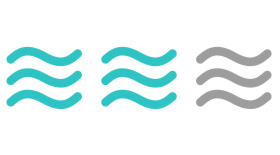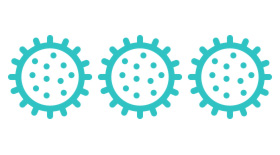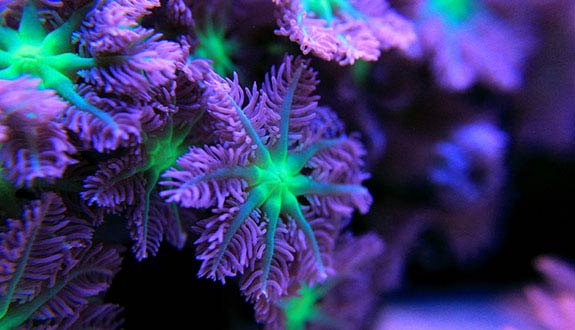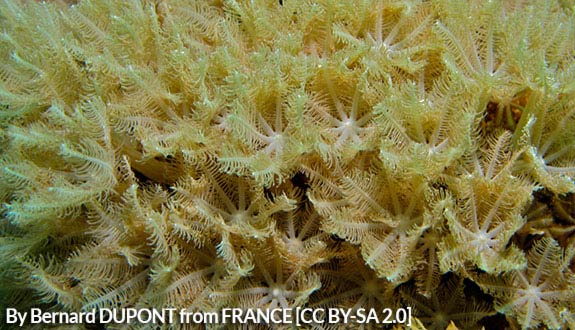

Alternative species (click on the thumbnail to see the card)
Names
Scientific name
Clavularia spp.
Common name
Clavularia
Origin

Origin: Indo-Pacific, Atlantic Ocean, Sea Mediterranean (from 15 to 50 m or 590" to 1970" of depth)
Kind

Kind: Soft Coral
Form: encrusting, it covers the rocks. Polyps are often iridescent green (violacea), chestnut, purple, beige or white.
Group

Clavulariidae
Volume

100 L / 22 imp gal / 26 US gal
Parameters

T°: 24 à 26°C or 75 to 79°F
pH: 7.5 to 8.5
Density: 1022 to 1026
Difficulty

Easy
Size

according to place available
Brewing

Average to strong
Lighting

Average to strong
Aggressiveness

Strong (toxic and invasive)
Food
How to feed the Clavularia?
Food
How to feed the Clavularia?
Like many corals, Clavularia has micro-algae growing in its interior. It feeds on these algae: it is its first source of food in its aquarium. It is therefore necessary to have a good lighting for these micro-algae (called zooxanthellae) to develop and that the coral can take nourishment.
Cohabitation
Who can live with the Clavularia?
Cohabitation
Who can live with the Clavularia?
Clavularia can secrete a toxic substance called terpenoids. Corals downstream of the stream can be the victims. Attention therefore to the proximity of other species of invertebrates (SPS hard corals in particular).
This species can also be quite invasive. Plan early some space around this coral so that it can grow appropriately.
Breeding
How to breed the Clavularia?
Breeding
How to breed the Clavularia?
Breeding of this invertebrate occurs by division of the parent colony. Its stolons are encrusted in the rock gradually. The Clavularia extends horizontally, covering all of the available space. You can cut an excrescence to install it at the desired place.
This expansion can be quite fast, and the introduction of a single colony is enough to fill the space you want to devote to it.
Its aquarium
Which aquarium for the Clavularia?
Its aquarium
Which aquarium for the Clavularia?
It will find its place among the rocks, algae and other corals of your reef aquarium, rather at the bottom of the tank (it tends to «climb» towards the light during its growth).
Be sure to install your Clavularia in moderate to intense light. It will also enjoy a good brew.
Filamentous algae can affect this soft coral. Only install this species when your aquarium is mature and well stabilized.




Good To know
Find all additional information!
Good To know
Find all additional information!
The polyps of Clavularia can retract entirely, especially at night. Normally, polyps unfold entirely during the day. If the polyps do not come out during the day, it may be due to poor water quality (pollution). Check your settings!
Often confused with Anthelia. Note, however, that it does not have the ability to retract its polyps like Clavularia.
Extremely robust, Clavularia is very easy to acclimatize, maintain and breed. A perfect choice for beginners in reef aquarium! This ability comes from the fact that they have no skeletal structure: this makes them more tolerant to variations in alkalinity, calcium and magnesium than other corals. However, they remain sensitive to variations in pH, temperature and salinity.
Like all corals, Clavularia can be irritating to the skin or even toxic to humans. Handle it with care and wear gloves.
There are 69 species of Clavularia! Let’s quote from Wikipedia:
Clavularia alba
Clavularia arctica
Clavularia australiensis
Clavularia bathybius
Clavularia borealis
Clavularia capensis
Clavularia carpediem
Clavularia charoti
Clavularia concreta
Clavularia crassa
Clavularia crosslandi
Clavularia cylindrica
Clavularia delicatula
Clavularia densum
Clavularia desjardiniana
Clavularia diademata
Clavularia dispersa
Clavularia durum
Clavularia eburnea
Clavularia elongata
Clavularia expansa
Clavularia filiformis
Clavularia filippi
Clavularia flava
Clavularia frankliniana
Clavularia frigida
Clavularia garcia
Clavularia grandiflora
Clavularia griegii
Clavularia inflata
Clavularia koellikeri
Clavularia laxa
Clavularia levidensis
Clavularia longissima
Clavularia magelhaenica
Clavularia margaritaceum
Clavularia margaritferae
Clavularia marioni
Clavularia mikado
Clavularia modesta
Clavularia molli
Clavularia morbesbii
Clavularia multispiculosa
Clavularia notanda
Clavularia novaezealandiae
Clavularia ornata
Clavularia pacifica
Clavularia parva
Clavularia parvula
Clavularia peterseni
Clavularia pregnans
Clavularia primula
Clavularia pulchra
Clavularia purpurascens
Clavularia racemosa
Clavularia ramosa
Clavularia repens
Clavularia reptans
Clavularia rigida
Clavularia spongicola
Clavularia stormi
Clavularia strumosa
Clavularia tenuis
Clavularia thalassanthos
Clavularia thompsoni
Clavularia venustella
Clavularia viridis
Clavularia zanzibarensis
Yours photos!
Comments
Sort by:
Please login to post comments
